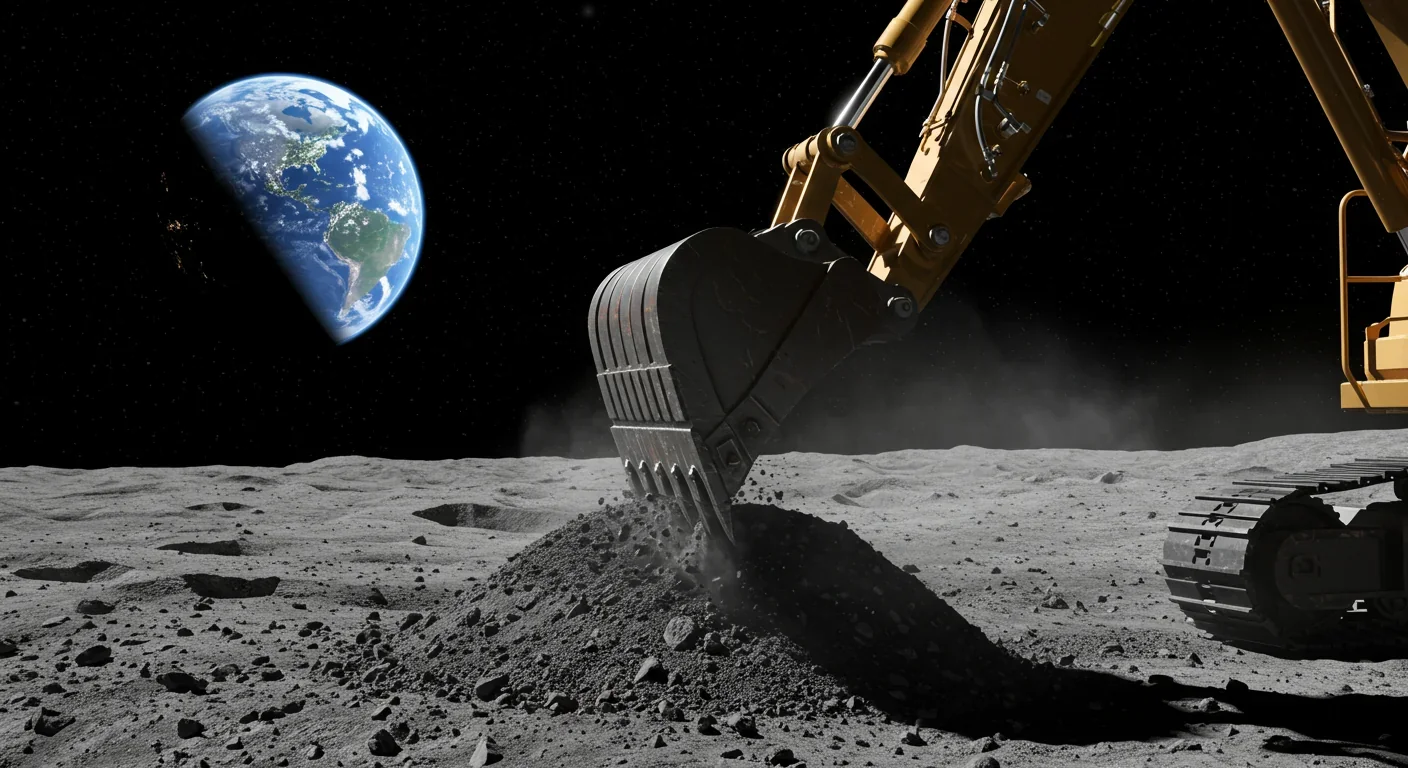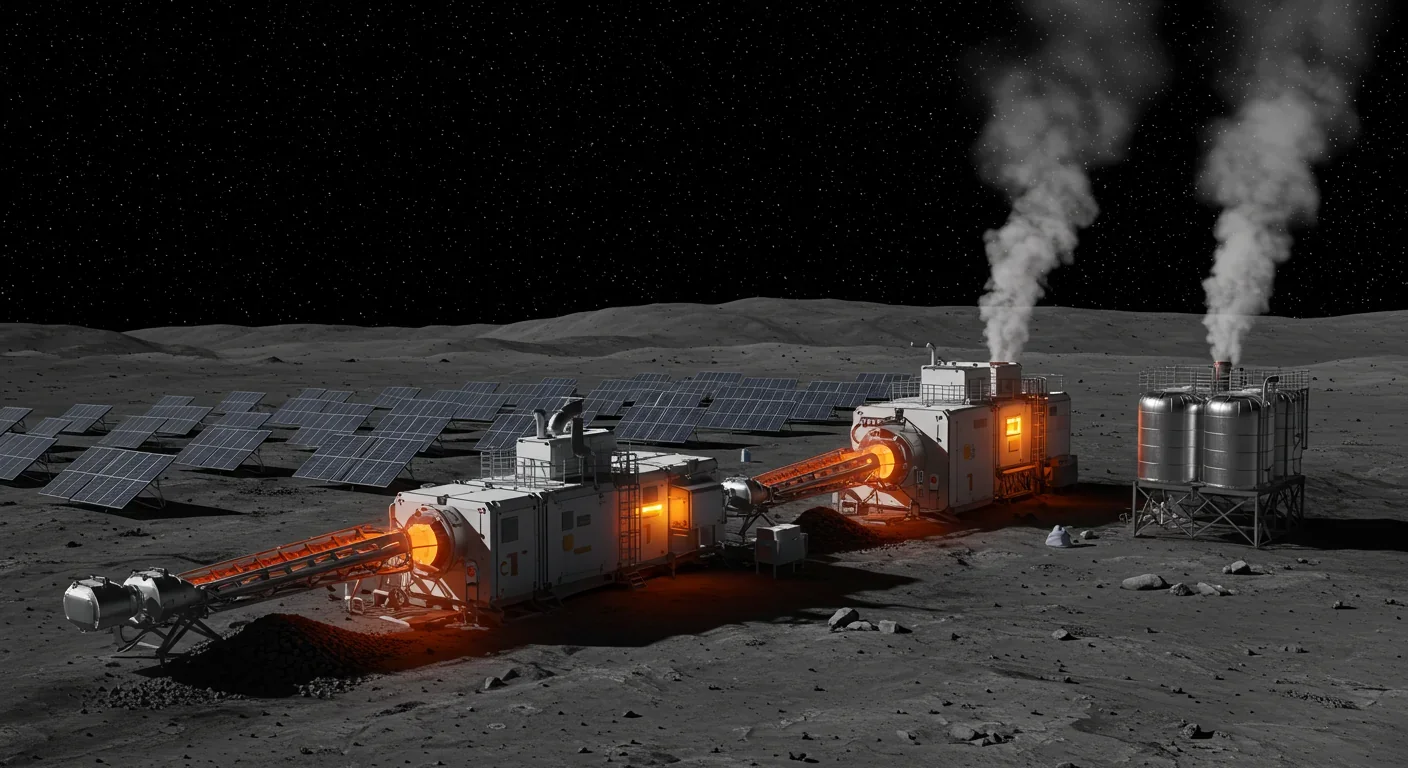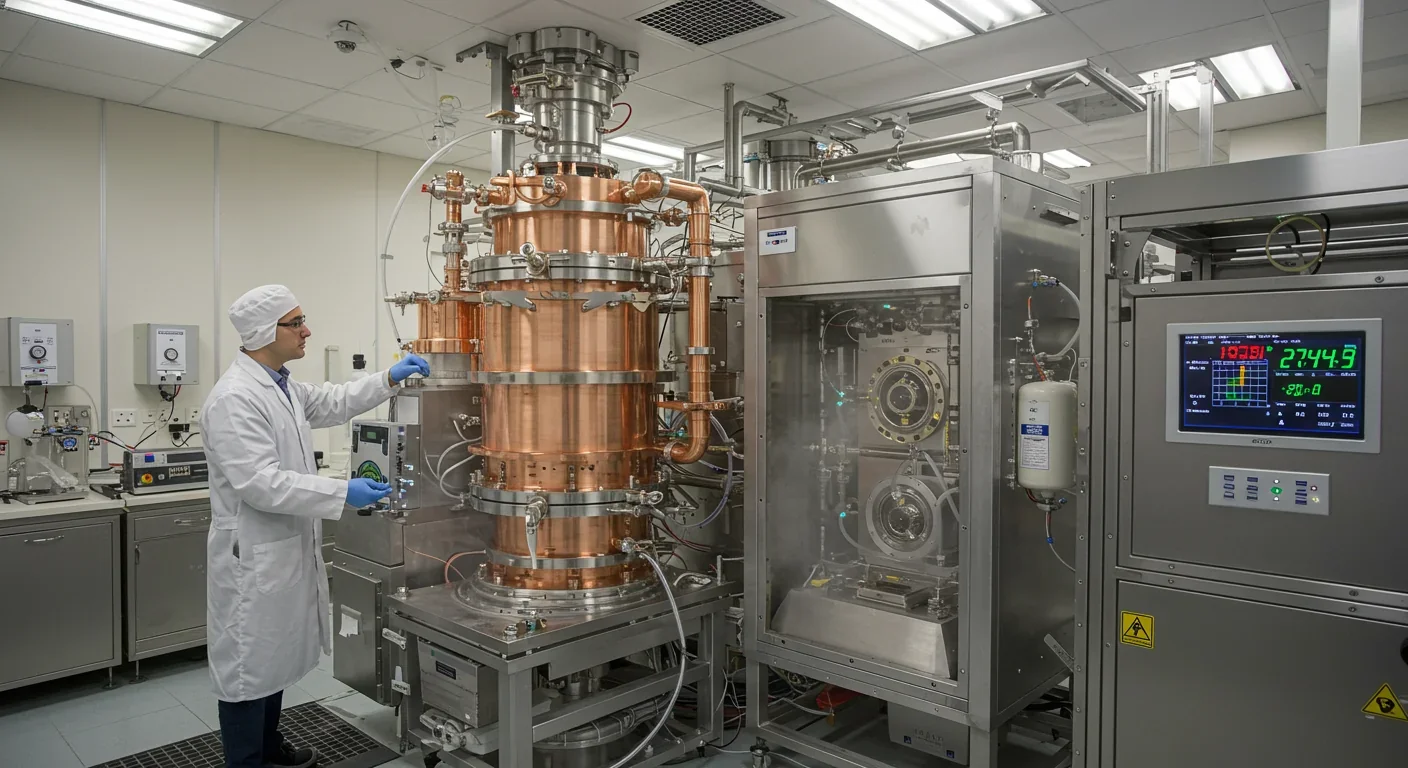Fusion Rockets Could Reach 10% Light Speed: The Breakthrough

TL;DR: Lunar Helium-3 mining is transitioning from science fiction to business reality, driven by quantum computing's immediate demand and fusion energy's long-term promise. Companies are building excavators, signing contracts, and navigating geopolitical tensions that could reshape energy security and space law.

In 2025, a quiet race is unfolding 240,000 miles above our heads. Companies like Interlune and Magna Petra aren't chasing science fiction anymore—they're signing contracts, building excavators, and mapping titanium deposits on the Moon. Their target? Helium-3, an isotope so rare on Earth that our entire annual production could fit in a minivan, yet abundant enough in lunar soil to potentially reshape energy, geopolitics, and humanity's relationship with space. What started as a fusion researcher's dream has evolved into something unexpected: a bridge commodity that quantum computers need right now, with fusion power as the long-term jackpot. The timeline is no longer measured in science-fiction centuries but in business quarters and mission launch windows.
Helium-3 is what physicists call an exotic isotope—two protons, one neutron, stable as a rock but vanishingly rare. Earth manufactures only 8,000 to 10,000 liters annually, mostly from tritium decay at places like the Savannah River Site. That scarcity makes it precious, but its nuclear properties make it revolutionary.
In fusion reactors, Helium-3 offers something deuterium-tritium reactions can't match: minimal neutron radiation and temperatures that, while still eye-watering, could be managed with technologies we're developing today. The reaction between deuterium and Helium-3 produces charged particles rather than neutrons, which means less radioactive waste, simpler reactor shielding, and energy that can be converted directly to electricity. It's the difference between wrestling a tiger and training a very powerful dog.
But here's the twist nobody saw coming a decade ago: quantum computing needs Helium-3 now. Every dilution refrigerator that chills qubits to near absolute zero runs on this isotope. As quantum technology scales from lab curiosities to commercial systems, that demand is spiking faster than fusion reactors are materializing. Interlune CEO Rob Meyerson told Space.com, "At $20 million a kilogram, you can put together a good business just going after Helium-3 for quantum computing over the next five to seven years". Bluefors, which builds cryogenic cooling systems, has already contracted to purchase up to 10,000 liters annually from Interlune starting in the late 2020s.
For billions of years, the solar wind—a steady stream of charged particles from the Sun—has been sandblasting the Moon's surface. Unlike Earth, which deflects this cosmic spray with its magnetic field and atmosphere, the Moon just sits there and takes it. Helium-3 from the solar wind gets implanted directly into lunar regolith, accumulating in concentrations of a few tens of parts per billion.
That sounds microscopic, and it is—but spread across the Moon's entire surface, it adds up to hundreds of thousands of tons. Apollo astronauts brought back samples confirming this treasure trove, though nobody knew what to do with it at the time. The highest concentrations correlate with titanium-bearing minerals like ilmenite. David Lawrence at Johns Hopkins Applied Physics Laboratory explained that "where one sees enhanced abundances of titanium, one can expect the largest amounts of Helium-3".
Interestingly, Earth isn't completely devoid of Helium-3 reserves. In Minnesota, Pulsar Helium's Topaz Project discovered concentrations up to 14.5 parts per billion in terrestrial gas wells—levels comparable to lunar averages. This terrestrial source raises an intriguing question: Could we mine Helium-3 here instead of launching to the Moon? The answer shapes how urgently we need to master lunar extraction, though the Moon's vastness still offers scale Earth can't match.
Mining Helium-3 from the Moon isn't like drilling for oil. You can't just sink a wellbore and pump it out. Instead, companies are designing systems to heat vast quantities of regolith to 800°C or higher, releasing embedded gases that can then be separated and liquefied.
Interlune partnered with Vermeer Corporation to build a full-scale excavator prototype capable of ingesting 100 metric tons of lunar regolith per hour. Imagine a conveyor-belt system continuously scooping, heating, extracting, and returning processed soil to the surface. Magna Petra, led by CEO Jeffrey Max, is pursuing a different approach: "mechanically disturbing the surface regolith to excite plumes of isotope in suspension, enabling collection of free-floating gas". It's less energy-intensive but requires precision and might yield lower concentrations.
Either way, the infrastructure is staggering. You need power generation (solar arrays, possibly nuclear), thermal management to handle the Moon's brutal day-night temperature swings, gas separation and liquefaction plants, and transport systems to ferry extracted Helium-3 back to Earth. DARPA's recent field guide on lunar economics highlighted thermal management as "a huge, fundamental problem"—without sophisticated heat plumbing, operations could only function a fraction of each lunar day.
Then there's mapping. Helium-3 concentrations are too low for direct gamma-ray detection, so missions like Blue Origin's Project Oasis and DARPA's LASSO are developing indirect methods, using titanium abundance as a proxy. Before anyone commits billions to a mining base, they need to know exactly where the richest deposits lie.

A decade ago, lunar Helium-3 extraction was a thought experiment. Today, it's a business plan with early customers. The U.S. Department of Energy has issued pilot contracts with Interlune, and Bluefors' agreement signals genuine demand beyond government labs.
At $20 million per kilogram, the math starts making sense for quantum computing applications. If fusion technology matures and Helium-3 becomes the preferred fuel, prices could stabilize or even drop as economies of scale kick in—or they could skyrocket if demand outstrips supply. Pulsar Helium's CEO noted that economic viability depends on both extraction costs and achieving practical fusion reactor technology, a reminder that this market has two moving parts.
Space insurance emerged as a surprising cost barrier, potentially as significant as launch expenses. Underwriters remain wary of lunar operations because there's no track record, no salvage options, and no emergency services 240,000 miles away. That uncertainty inflates premiums and could delay commercial operations unless early missions establish safety records.
Still, Helium-3 is being positioned as the Moon's first real export commodity, one that can finance the landers, capsules, and logistics infrastructure that deeper lunar exploration requires. It's a feedback loop: quantum computing creates immediate revenue, which funds the buildout needed for eventual fusion applications.
The geopolitical stakes are impossible to ignore. China and the United States are locked in what analysts call "orbital rivalry", competing not just for scientific prestige but for access to lunar resources that could underpin future energy security and technological leadership.
China's lunar sample-return missions and plans for a permanent research station signal long-term ambitions. The real battle for the Moon's resources, as one analysis put it, is happening here on Earth—in treaty negotiations, corporate partnerships, and domestic policies that determine who gets to claim what. The 1967 Outer Space Treaty prohibits national sovereignty over celestial bodies, but it's silent on resource extraction by private companies. Legal scholars are now grappling with questions like "Who owns the Moon?" as companies file claims and governments issue mining licenses.
This legal ambiguity could become a flashpoint. If one nation's companies stake out the richest Helium-3 deposits and others are shut out, tensions could escalate quickly. Some experts advocate for international agreements modeled on Antarctic treaties or deep-sea mining conventions, establishing shared governance and benefit-sharing mechanisms. Others argue that the space economy cannot succeed without clear private ownership rights, which would incentivize investment but risk geopolitical conflict.
The European Space Agency, Japan's ispace, and emerging space powers like India and the UAE are also positioning themselves in this race. Luxembourg, for instance, has partnered with Blue Origin on Project Oasis, aiming to map lunar resources and establish a foothold in the nascent lunar economy. The implication is clear: whoever masters lunar Helium-3 extraction first gains not just a commodity but leverage over quantum computing supply chains, fusion energy timelines, and the broader architecture of space exploration.
While quantum computing provides the immediate business case, fusion energy remains the ultimate prize. Facilities like ITER are inching toward net-positive fusion, and if deuterium-Helium-3 reactions prove viable at scale, the energy implications are staggering. A single kilogram could theoretically generate enough power to sustain a small city for weeks.
Yet fusion has been "30 years away" for the past 70 years. Skeptics point out that even if we achieve controlled deuterium-Helium-3 fusion in lab settings, building commercially viable reactors is another monumental challenge. Plasma containment, reactor materials that can withstand extreme conditions, and energy conversion systems all need breakthroughs. Helium-3 sits at the intersection of homeland security, energy security, and technological leadership, but that intersection is still under construction.
If fusion does mature, the geopolitical landscape transforms overnight. Energy-importing nations could become self-sufficient. Carbon emissions from fossil fuels could collapse. The global balance of power shifts when energy scarcity evaporates. That's why governments are funding lunar Helium-3 research even though fusion reactors remain speculative—it's an insurance policy against being left behind in a post-carbon world.

Not everyone is cheering. Environmental advocates worry that lunar mining could disrupt scientific study of the Moon's geological history. Once regolith is excavated and processed, pristine samples are gone forever. Some planetary scientists argue for designated conservation zones, akin to national parks, to preserve areas of scientific interest.
There's also the risk of a resource gold rush that mirrors historical patterns of exploitation and conflict. Tensions over lunar resources could spill over into broader international relations, especially if profit-driven companies and rival nations clash over prime extraction sites. The absence of clear legal frameworks amplifies this danger.
And what if Helium-3 mining succeeds brilliantly but fusion reactors don't? We could end up with expensive lunar infrastructure optimized for a technology that never pans out commercially, leaving quantum computing as the sole beneficiary. That wouldn't be catastrophic—quantum tech is transformative in its own right—but it would mean overselling fusion as the endgame.
Within the next decade, you'll likely see quantum computers solving problems that classical machines can't touch—drug discovery, cryptography, climate modeling—powered in part by Helium-3 mined on the Moon. The rise of quantum computing is already being linked to lunar Helium-3 supply chains.
If fusion energy follows, the changes cascade into every corner of life. Electricity could become so cheap and abundant that desalination, carbon capture, and electric transport become trivial to scale. Geopolitical flashpoints centered on oil and gas could fade. Climate change mitigation gets a technological boost we've never had before.
But the transition won't be smooth. Workers in fossil fuel industries will need new skills. Nations dependent on energy exports will face economic upheaval. Equity questions loom: Will Helium-3-powered fusion be accessible globally, or will it deepen divides between haves and have-nots?
You might also see a generation growing up with a fundamentally different relationship to space. If the Moon transitions from a symbolic destination to an industrial zone, our cultural mythology shifts. Kids who watch rovers harvest regolith in real-time might think of space not as the final frontier but as the next job site.
For individuals, the skills to develop are multidisciplinary: robotics, cryogenics, space law, supply chain logistics, and planetary science. NASA and private firms are already funding early purchase agreements for regolith heating, gas separation, and transport technologies, creating career pathways that didn't exist five years ago.
For policymakers, the challenge is crafting international frameworks that balance competition with cooperation. The coming fight over space law and treaties will define who benefits and who gets left out. Getting this wrong could poison space relations for generations; getting it right could establish precedents for resource-sharing that ripple back to Earth.
For investors, lunar Helium-3 represents a frontier market with asymmetric risk and reward. Early movers like Interlune, Magna Petra, and Pulsar Helium are placing bets that could pay off spectacularly or fizzle if technical hurdles prove insurmountable. Diversification across extraction technologies, quantum applications, and fusion research hedges against single points of failure.
Ultimately, the Helium-3 story is less about an isotope and more about how humanity handles abundance in a new context. We've spent centuries fighting over finite resources on a single planet. The Moon offers a test case: Can we build systems that distribute benefits equitably, avoid repeating colonial patterns, and use technological breakthroughs to lift everyone rather than concentrating power?
The contracts being signed today, the excavators being tested, and the legal arguments being drafted are all writing the rough draft of that future. What happens when technology becomes accessible to everyone? That question will define the next phase of human civilization, and Helium-3 is forcing us to answer it sooner than we thought.
By 2030, lunar Helium-3 extraction could be routine, quantum computers could be running on Moon-sourced fuel, and fusion reactors might be inching closer to commercial viability. Or we could still be arguing over mining rights while terrestrial sources like Minnesota's Topaz Project supply the quantum market. Either way, the fact that we're having these conversations at all—mapping the Moon, signing purchase agreements, debating space law—signals a turning point.
The Moon isn't just reflecting sunlight anymore. It's reflecting our ambitions, our anxieties, and our capacity to build futures we can barely imagine. Whether that future is powered by Helium-3 or something else entirely, the leap from moon dust to power plants has already begun.

Recent breakthroughs in fusion technology—including 351,000-gauss magnetic fields, AI-driven plasma diagnostics, and net energy gain at the National Ignition Facility—are transforming fusion propulsion from science fiction to engineering frontier. Scientists now have a realistic pathway to accelerate spacecraft to 10% of light speed, enabling a 43-year journey to Alpha Centauri. While challenges remain in miniaturization, neutron management, and sustained operation, the physics barriers have ...

Epigenetic clocks measure DNA methylation patterns to calculate biological age, which predicts disease risk up to 30 years before symptoms appear. Landmark studies show that accelerated epigenetic aging forecasts cardiovascular disease, diabetes, and neurodegeneration with remarkable accuracy. Lifestyle interventions—Mediterranean diet, structured exercise, quality sleep, stress management—can measurably reverse biological aging, reducing epigenetic age by 1-2 years within months. Commercial ...

Data centers consumed 415 terawatt-hours of electricity in 2024 and will nearly double that by 2030, driven by AI's insatiable energy appetite. Despite tech giants' renewable pledges, actual emissions are up to 662% higher than reported due to accounting loopholes. A digital pollution tax—similar to Europe's carbon border tariff—could finally force the industry to invest in efficiency technologies like liquid cooling, waste heat recovery, and time-matched renewable power, transforming volunta...

Humans are hardwired to see invisible agents—gods, ghosts, conspiracies—thanks to the Hyperactive Agency Detection Device (HADD), an evolutionary survival mechanism that favored false alarms over fatal misses. This cognitive bias, rooted in brain regions like the temporoparietal junction and medial prefrontal cortex, generates religious beliefs, animistic worldviews, and conspiracy theories across all cultures. Understanding HADD doesn't eliminate belief, but it helps us recognize when our pa...

The bombardier beetle has perfected a chemical defense system that human engineers are still trying to replicate: a two-chamber micro-combustion engine that mixes hydroquinone and hydrogen peroxide to create explosive 100°C sprays at up to 500 pulses per second, aimed with 270-degree precision. This tiny insect's biochemical marvel is inspiring revolutionary technologies in aerospace propulsion, pharmaceutical delivery, and fire suppression. By 2030, beetle-inspired systems could position sat...

The U.S. faces a catastrophic care worker shortage driven by poverty-level wages, overwhelming burnout, and systemic undervaluation. With 99% of nursing homes hiring and 9.7 million openings projected by 2034, the crisis threatens patient safety, family stability, and economic productivity. Evidence-based solutions—wage reforms, streamlined training, technology integration, and policy enforcement—exist and work, but require sustained political will and cultural recognition that caregiving is ...

Every major AI model was trained on copyrighted text scraped without permission, triggering billion-dollar lawsuits and forcing a reckoning between innovation and creator rights. The future depends on finding balance between transformative AI development and fair compensation for the people whose work fuels it.